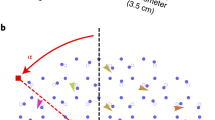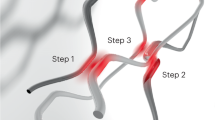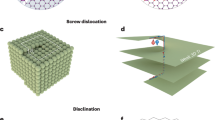Abstract
Topological invariants characterizing filled Bloch bands underpin electronic topological insulators and analogous artificial lattices for Bose–Einstein condensates, photonics and acoustic waves. In bosonic systems, there is no Fermi exclusion principle to enforce uniform band filling, which makes measuring their bulk topological invariants challenging. Here we show how to achieve the controllable filling of bosonic bands using leaky photonic lattices. Leaky photonic lattices host transitions between bound and radiative modes at a critical energy, which plays a role analogous to the electronic Fermi level. Tuning this effective Fermi level into a bandgap results in the disorder-robust dynamical quantization of bulk topological invariants such as the Chern number. Our findings establish leaky lattices as a highly flexible platform for exploring topological and non-Hermitian wave physics.
This is a preview of subscription content, access via your institution
Access options
Access Nature and 54 other Nature Portfolio journals
Get Nature+, our best-value online-access subscription
$29.99 / 30 days
cancel any time
Subscribe to this journal
Receive 12 print issues and online access
$209.00 per year
only $17.42 per issue
Buy this article
- Purchase on Springer Link
- Instant access to full article PDF
Prices may be subject to local taxes which are calculated during checkout





Similar content being viewed by others
Data availability
Source data are provided with this paper. All other data that support the plots within this paper and other findings of this study are available from the corresponding author upon reasonable request.
Code availability
The code used to perform the numerical simulations within this paper is available from the corresponding author upon reasonable request.
References
Hasan, M. Z. & Kane, C. L. Colloquium: topological insulators. Rev. Mod. Phys. 82, 3045 (2010).
Ozawa, T. et al. Topological photonics. Rev. Mod. Phys. 91, 015006 (2019).
Goldman, N., Budich, J. C. & Zoller, P. Topological quantum matter with ultracold gases in optical lattices. Nat. Phys. 12, 639–645 (2016).
Ma, G., Xiao, M. & Chan, C. T. Topological phases in acoustic and mechanical systems. Nat. Rev. Phys. 1, 281–294 (2019).
Hu, W. et al. Measurement of a topological edge invariant in a microwave network. Phys. Rev. X 5, 011012 (2015).
Mittal, S., Ganeshan, S., Fan, J., Vaezi, A. & Hafezi, M. Measurement of topological invariants in a 2D photonic system. Nat. Photon. 10, 180–183 (2016).
Bardyn, C.-E., Huber, S. D. & Zilberberg, O. Measuring topological invariants in small photonic lattices. New J. Phys. 16, 123013 (2014).
Aidelsburger, M. et al. Measuring the Chern number of Hofstadter bands with ultracold bosonic atoms. Nat. Phys. 11, 162–166 (2015).
Wimmer, M., Price, H. M., Carusotto, I. & Peschel, U. Experimental measurement of the Berry curvature from anomalous transport. Nat. Phys. 13, 545–550 (2017).
Tarnowski, M. et al. Measuring topology from dynamics by obtaining the Chern number from a linking number. Nat. Commun. 10, 1728 (2019).
Ching, E. S. C. et al. Quasinormal-mode expansion for waves in open systems. Rev. Mod. Phys. 70, 1545–1554 (1998).
Hu, J. & Menyuk, C. R. Understanding leaky modes: slab waveguide revisited. Adv. Opt. Photon. 1, 58–106 (2009).
Monticone, F. & Alù, A. Leaky-wave theory, techniques, and applications: from microwaves to visible frequencies. Proc. IEEE 103, 793–821 (2015).
Stowell, D. & Tausch, J. Variational formulation for guided and leaky modes in multilayer dielectric waveguides. Commun. Comput. Phys. 7, 564–579 (2010).
Powell, D. A. Interference between the modes of an all-dielectric meta-atom. Phys. Rev. Appl. 7, 034006 (2017).
Pick, A. & Moiseyev, N. Polarization dependence of the propagation constant of leaky guided modes. Phys. Rev. A 97, 043854 (2018).
Lalanne, P., Yan, W., Vynck, K., Sauvan, C. & Hugonin, J.-P. Light interaction with photonic and plasmonic resonances. Laser Photon. Rev. 12, 1700113 (2018).
Fukui, T., Hatsugai, Y. & Suzuki, H. Chern numbers in discretized Brillouin zone: efficient method of computing (spin) Hall conductances. J. Phys. Soc. Jpn 74, 1674–1677 (2005).
Bianco, R. & Resta, R. Mapping topological order in coordinate space. Phys. Rev. B 84, 241106(R) (2011).
Ringel, Z. & Kraus, Y. E. Determining topological order from local ground-state correlation function. Phys. Rev. B 83, 245115 (2011).
Chiu, C.-K., Teo, J. C. Y., Schnyder, A. P. & Ryu, S. Classification of topological quantum matter with symmetries. Rev. Mod. Phys. 88, 035005 (2016).
Golshani, M. et al. Impact of loss on the wave dynamics in photonic waveguide lattices. Phys. Rev. Lett. 113, 123903 (2014).
Longhi, S., Gatti, D. & Della Valle, G. Non-Hermitian transparency and one-way transport in low-dimensional lattices by an imaginary gauge field. Phys. Rev. B 92, 094204 (2015).
Longhi, S. Non-Hermitian tight-binding network engineering. Phys. Rev. A 93, 022102 (2016).
Leykam, D., Flach, S. & Chong, Y. D. Flat bands in lattices with non-Hermitian coupling. Phys. Rev. B 96, 064305 (2017).
Mukherjee, S. et al. Dissipatively coupled waveguide networks for coherent diffusive photonics. Nat. Commun. 8, 1909 (2017).
Esaki, K., Sato, M., Hasebe, K. & Kohmoto, M. Edge states and topological phases in non-Hermitian systems. Phys. Rev. B 84, 205128 (2011).
Gong, Z. et al. Topological phases of non-Hermitian systems. Phys. Rev. X 8, 031079 (2018).
Gorlach, M. A. et al. Far-field probing of leaky topological states in all-dielectric metasurfaces. Nat. Commun. 9, 909 (2018).
El-Ganainy, R. et al. Non-Hermitian physics and PT symmetry. Nat. Phys. 14, 11–19 (2018).
Yoshida, T. & Hatsugai, Y. Exceptional rings protected by emergent symmetry for mechanical systems. Phys. Rev. B 100, 054109 (2019).
Tisseur, F. & Meerbergen, K. The quadratic eigenvalue problem. SIAM Rev. 43, 235–286 (2001).
Atala, M. et al. Observation of chiral currents with ultracold atoms in bosonic ladders. Nat. Phys. 10, 588–593 (2014).
Gerchberg, R. W. & Saxton, W. O. A practical algorithm for the determination of the phase from image and diffraction plane pictures. Optik 35, 237–246 (1972).
Malkova, N., Hromada, I., Wang, X., Bryant, G. & Chen, Z. Observation of optical Shockley-like surface states in photonic superlattices. Opt. Lett. 34, 1633–1635 (2009).
Bartal, G. et al. Brillouin zone spectroscopy of nonlinear photonic lattices. Phys. Rev. Lett. 94, 163902 (2005).
Rudner, M. S. & Levitov, L. S. Topological transition in a non-Hermitian quantum walk. Phys. Rev. Lett. 102, 065703 (2009).
Zeuner, J. M. et al. Observation of a topological transition in the bulk of a non-Hermitian system. Phys. Rev. Lett. 115, 040402 (2015).
Wang, Y. et al. Direct observation of topology from single-photon dynamics. Phys. Rev. Lett. 112, 193903 (2019).
St-Jean, P. et al. Measuring topological invariants in polaritonic graphene. Preprint at https://arxiv.org/abs/2002.09528 (2020).
Cerjan, A., Hsu, C. W. & Rechtsman, M. C. Bound states in the continuum through environmental design. Phys. Rev. Lett. 123, 023902 (2019).
Wang, Q. et al. Measurement of the Zak phase of photonic bands through the interface states of a metasurface/photonic crystal. Phys. Rev. B 93, 041415(R) (2016).
Longhi, S. Probing topological phases in waveguide superlattices. Opt. Lett. 44, 2530–2533 (2019).
Noh, J., Huang, S., Chen, K. P. & Rechtsman, M. C. Observation of photonic topological valley Hall edge states. Phys. Rev. Lett. 120, 063902 (2018).
Blanco-Redondo, A. et al. Topological optical waveguiding in silicon and the transition between topological and trivial defect states. Phys. Rev. Lett. 116, 163901 (2016).
Caio, M. D., Möller, G., Cooper, N. R. & Bhaseen, M. J. Topological marker currents in Chern insulators. Nat. Phys. 15, 257–261 (2019).
Viyuela, O., Rivas, A. & Martin-Delgado, M. A. Uhlmann phase as a topological measure for one-dimensional fermion systems. Phys. Rev. Lett. 112, 130401 (2014).
Atala, M. et al. Direct measurement of the Zak phase in topological Bloch bands. Nat. Phys. 9, 795–800 (2013).
Vanderbilt, D. Berry Phases in Electronic Structure Theory (Cambridge Univ. Press, 2018).
Haldane, F. D. M. Model for a quantum Hall effect without Landau levels: condensed-matter realization of the ‘parity anomaly’. Phys. Rev. Lett. 61, 2015–2018 (1988).
Acknowledgements
We thank A. Cerjan, Z. Chen, Y. Chong and M. Rechstman for illuminating discussions. D.L. was supported by the Institute for Basic Science (IBS-R024-Y1 and IBS-R024-D1). D.A.S. acknowledges funding from the Australian Research Council’s Early Career Researcher Award (DE190100430) and the Russian Science Foundation (Grant No. 20-72-00148).
Author information
Authors and Affiliations
Contributions
D.L. and D.A.S. both performed the research and wrote the manuscript.
Corresponding author
Ethics declarations
Competing interests
The authors declare no competing interests.
Additional information
Peer review information Nature Physics thanks the anonymous reviewers for their contribution to the peer review of this work.
Publisher’s note Springer Nature remains neutral with regard to jurisdictional claims in published maps and institutional affiliations.
Extended data
Extended Data Fig. 1 Leaky photonic lattice design for laser-written waveguides.
(a) Schematic of a leaky photonic lattice formed by an array of 18 primary waveguides (red) weakly coupled to auxiliary arrays forming the environment. The alternating position of the environment arrays above and below the primary array can be used to minimise unwanted direct coupling between the auxiliary arrays. (b) Corresponding tight binding model. (c,d,e) Dynamics of observables in the primary array: (c) the total norm \({\mathcal{N}}={\sum }_{m}| {\psi }_{m}{| }^{2}\), (d) the mean displacement \(\Delta x={\sum }_{m}(m-x(0))| {\psi }_{m}{| }^{2}/{\mathcal{N}}\), and (e) the Zak phase ν. Error bars in (d,e) indicate one standard deviation obtained using an ensemble of 100 disorder realizations.
Extended Data Fig. 2 Leaky photonic lattice design for silicon photonics.
(a) Schematic of a dimerized array of 10 silicon waveguides with labelled dimensions. Trivial and nontrivial arrangements differ by the intersite gaps ordering: g1 > g2 (trivial), g1 < g2 (nontrivial). (b,c) Field profiles of eigenmodes from the upper (b, neff = 1.8154) and lower bands (c, neff = 1.6735 − 0.0014i) in the trivial array. (d) Power and (e,f) Zak phase obtained from the field projection operator summed over excitations of the 5th and 6th waveguides in the trivial (e, blue curves) and nontrivial (f, gold curves) arrays. For comparison, grey curves in (e,f) show the Zak phase estimated from the single 5th waveguide excitation.
Supplementary information
Supplementary Information
Discussion and Supplementary Fig 1.
Source data
Source Data Fig. 2
Source data for Fig. 2c,d.
Source Data Fig. 3
Source data for Fig. 3d,e.
Source Data Fig. 4
Source data for Fig. 4b,c.
Source Data Fig. 5
Source data for Fig. 5.
Rights and permissions
About this article
Cite this article
Leykam, D., Smirnova, D.A. Probing bulk topological invariants using leaky photonic lattices. Nat. Phys. 17, 632–638 (2021). https://doi.org/10.1038/s41567-020-01144-5
Received:
Accepted:
Published:
Issue Date:
DOI: https://doi.org/10.1038/s41567-020-01144-5
This article is cited by
-
Direct extraction of topological Zak phase with the synthetic dimension
Light: Science & Applications (2023)
-
Stabilizing multiple topological fermions on a quantum computer
npj Quantum Information (2022)



